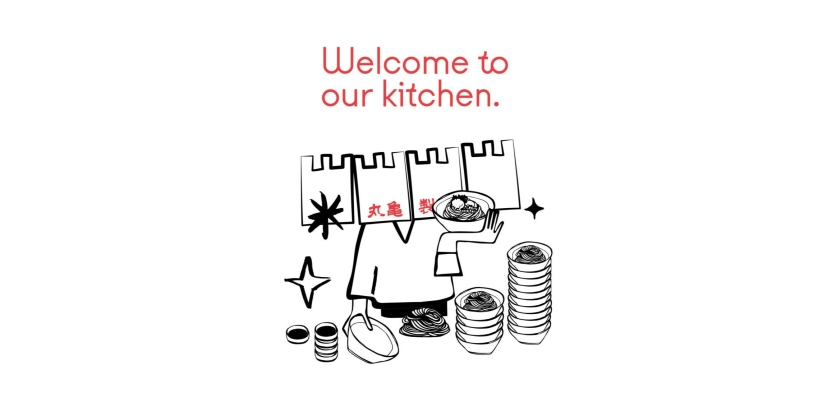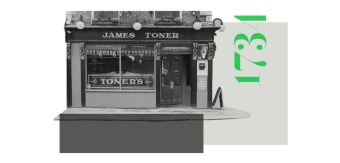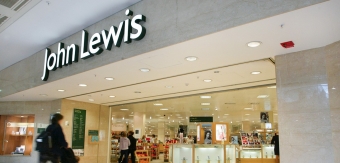This week we sat down with Kevin Grima, Creative Director at Harrison, to discuss how the 360 branding agency worked with casual dining Udon noodle restaurant Marugame Udon to bring the authentic Japanese experience to the UK market.
What was the brief for the rebrand?
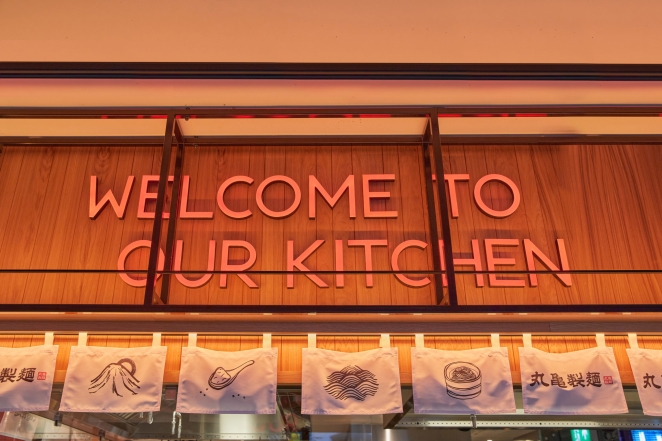
Despite being well-established within its home market in Japan, Marugame Udon had no recognised presence or customer base in the UK. As the brand’s first venture into Europe, we were tasked with creating a concept, brand identity, and strategy for the UK market – and subsequently Europe – which would:
- Showcase the authenticity and simplicity of Marugame Udon – keeping the business true to its roots, whilst adapting the brand to become accessible for a European audience.
- Introduce UK diners to udon noodles – while Japanese cuisine and ramen were both trending, udon itself was still seen as a niche food for those ‘in the know’. Marugame Udon wanted to turn it into a sought-after day to day delicacy.
- Positioning it as a trusted, authentic reliable brand which, in Japan, is part of an ‘everyday ritual’. Recreating the feeling of daily ritual to for a UK audience.
- Target a predominantly younger age group – millennials and ‘older’ Generation Z
- Stand out, capture the imagination and have a clear point of difference from other existing UK Asian options.
- Take diners on a Japanese journey, inform, and educate on culture and important philosophies such as Wabi Sabi – especially during a time when many people were unable to travel to Japan.
What’s more, in a marketplace with other popular Japanese restaurants all with their own USPs, the challenge was to shape the Marugame Udon brand proposition to ensure it maintained its strong connection to Japan and Japanese philosophies, whilst having USP to appeal to the UK audience.
How did the initial pitch/brainstorming phase go?
Getting under the skin of the Japanese culture and gaining a genuine understanding of how to create a truly authentic experience for people in the UK was crucial.
One of the biggest challenges, however, was when we started the process, we were unable to travel to Japan due to COVID restrictions. This meant many hours on the phone to our new client, lots of virtual ‘tours’, and hours’ worth of research.
Crucial to success from the beginning and ensuring the brand positioning was correct – which would become the foundations for everything else – was undertaking a thorough brand synthesis.
This covered everything from the brand essence and key values, through to who the target audience is and what they are looking for in a QSR, competition analysis and delving into what makes Marugame Udon different, and much more.
It was this brand synthesis which was the cornerstone of the project and further cemented Harrison’s credibility. The client could see the time our team put into researching the nuances of Japanese culture, and the effort into how to translate those in the UK.
They knew we had a deep understanding of what diners want – authentic and real brands, not gimmicks – and the talent in our team to properly execute their vision.
Describe the purpose of the brand and its target audience
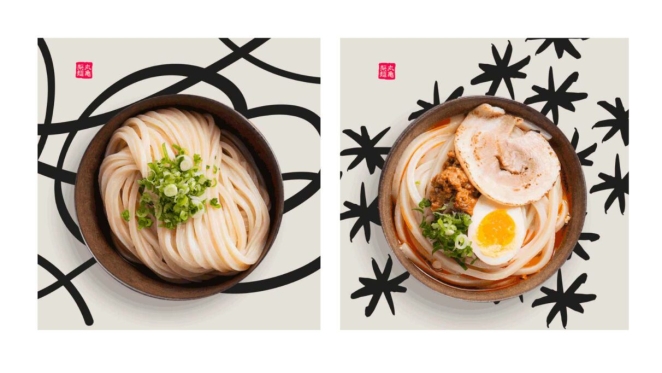
In an age where lives are busy and budgets are tight, finding quick, nourishing, great value meals that taste good enough to keep adventurous palates interested is a constant challenge.
Marugame Udon’s purpose was to be first to share the authentic, everyday Japanese custom with hungry European diners, allowing them to discover the goodness and pleasure of freshly prepared udon, and the uplifting energy of the bustling Udon kitchen.
Marugame Udon delivers their purpose by being Japan’s favourite Udon specialist – sharing the simple pleasure of eating this authentic everyday ritual. The freshest Udon noodles and tempura – handmade healthier and tastier, served from the warm heart of an exciting and energetic Udon kitchen.
The target audience includes those within the Gen Z and Millennials generations. The bullseye target audience would be someone who enjoys the simple things in life and convenience at most.
They enjoy socialising with friends and would rather have a quick and easy meal without all the fuss. The overall messaging of their favourite brands is clear and easy to understand and they love to try new things and make each moment count.
The target market is essentially looking for rational and emotive benefits, such as:
- Shareable experiences
- Authenticity
- Atmosphere/Entertainment
- Speed/Convenience
- Quality and flavour/ healthy choices
- Great value
Marugame Udon allows their target market to get a fulfilling meal in whichever way they wish. Whether their customers wish to dine-in at a table or order a takeaway, there is flexibility for all kinds of experiences.
What was your thinking behind the branding solution?
When people stepped into Marugame Udon, we wanted them to feel as if they had been transported to an udon restaurant in Japan. It was crucial the branding, storytelling and customer journey fed into this.
The story of Marugame Udon begins before a customer even steps inside.
Outside the restaurant, LCD screens give a birds-eye view into the kitchen, with live feeds into Marugame Udon kitchens in the UK and Tokyo to allow passers-by and potential customers to be drawn in.
Sculptural illuminated neon noodles hang from wooden beams which can be seen both inside and through large windows, replicating the traditional process of hanging and drying noodles. Every time the door is opened, the smells waft outside…
As the customer steps through the door, they enter the kitchen, instantly awakening the senses. All the sights, smells, and sounds you would expect from a busy working kitchen are all there to build anticipation and excitement for their upcoming dining experience.
When it comes to the branding itself, we wanted the branding to so clear and eventually become so iconic so even if the name was removed, people would understand the concept.
The brand story continues to unfold through the illustrations which are a key element of the branding solutions, and can be found throughout the restaurant as well as incorporated on the trays, menus, takeaway packaging, website, etc.
Some people might think the branding in the restaurant is the most important, but by having a brand which is consistently weaved through every touchpoint ensures the Marugame Udon story is continued to be told if a customer orders delivery, for example, or even before they visit.
Essentially, what you see today in the UK is an evolution of the brand, and the result of intensive research into what makes a truly authentic Japanese restaurant coupled with our extensive knowledge of what appeals and engages UK customers.
Combining the two together, we have created a restaurant which brings the flavours, sights, and experience of stepping into a Japanese noodle restaurant to UK diners.
Did you learn anything new during the project?
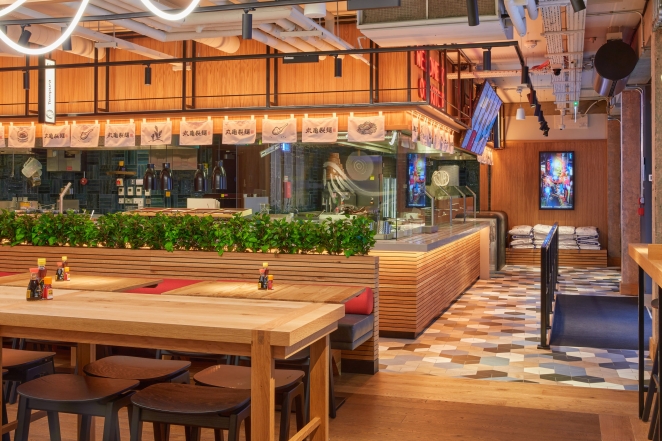
One of the biggest learnings for us was around the concept of ‘tray service’. Not well-embraced in the UK, and often burdened with connotations of canteens and schools, when we designed the first unit, we believed the moving along the kitchen with a tray would be a big enough step for the UK customer. Thinking they would then clear their own tray and bring it to a drop point, as they do in Japan, we thought was a step to far.
However, customers quickly showed us they can – as always – be unpredictable and would happily clear after themselves. So, after the first opening we made sure to install clear tray trolley areas.
Other things we learned included:
- Not all customers will embrace traveling down the kitchen. For those who want a more traditional-style table service, we installed touchscreens as an easy solution. Customers can decide how they would like to go about their dining experience – whether it be order at kiosks or have a sit-down meal.
- To incorporate the ongoing popularity of delivery/online takeaway services in the UK, we created a space to accommodate two lines – one for restaurant patrons and one for takeaways and deliveries to ensure all customers – whether in the restaurant or at home – got the best possible service.
- In the UK, we are more used to all-day dining experiences and restaurants which easily transition from day, to night. At Marugame Udon, we incorporated clever lighting changes to allow the evening to feel more intimate, a change in music, and the introduction of alcoholic drinks later in the day.
What kit/tools/software were used to create it?
We utilise several methodologies to develop the brand, such as Adobe Creative Suite for brand creation, and 3D modelling tools including Sketchup and D5.
What details are you most proud of and why?
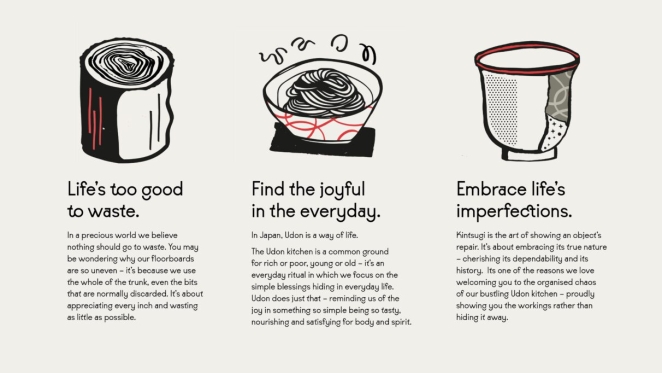
Ensuring key Japanese philosophies were incorporated into the UK restaurants was paramount. For example, the art of Wabi Sabi is all about embracing imperfection. This includes cracks, tears, distorted figures, and details which add character. This principle is at the heart of Marugame Udon, and one we have focused on from the original idea creation right through to the latest opening.
It can be felt in a multitude of different elements in each individual restaurant – from the knots, wears, and tears in the materials used, to how the team developed the graphics, and even the hand painted characters and illustration in every restaurant. Everything links back to the principle of embracing the imperfections.
By embracing the simplicity of Japanese design and incorporating ‘Japanese’ detailing and simple colour palettes, we ensured Marguame Udon would resonate well within the UK market. Small details heighten the brand story which is subtly told to customers through layers of different touchpoints, ultimately creating a true sense of authenticity. These include:
- Open kitchen to showcase the fresh, healthy, quality ingredients and the skills of the chefs. Diners are essentially entertained by the goings-on in the kitchen as they order their food.
- Japanese details which incorporate Wabi Sabi principles applied to design, for example high tables are made using sustainable, local materials but using mortar joints that go back to Japanese joinery, and flooring with knots and kinks as opposed to uniform perfection.
- Using traditional landscape imagery. Harrison’s inspiration was taken from end profiles of Japanese roof tiles to form textured clay wall features.
- Art commissioned from Japanese diaspora celebrates emerging creative talent and creates another connection to the restaurant’s Japanese roots.
- Learning Japanese. Our toilets provide guests with a unique way of leaning day to day Japanese expressions and simple sentences, to reinforce the authenticity of this brand.
Ultimately, all the design elements have been carefully curated to create the brand DNA of Marugame Udon. What you see today is the result of intensive research into what makes a truly authentic Japanese restaurant coupled with our extensive knowledge of what appeals to UK customers.
What visual influences fueled your solution?
We looked a variety of different Japanese restaurants – in Japan, in the UK, and globally – and took inspiration from what felt to us most authentic and relevant. These were then translated into elements we could use in the Marugame Spaces, such as:
- The timber rail which is functional to hang Noren (traditional Japanese fabric dividers) but also creates clean lines throughout the restaurant.
- Screens to add interest and texture but made using simple colour palettes and natural materials all based/inspired by Japanese design and ethos so it feels authentic not fake.
- An udon light feature which has become a central and iconic feature of each restaurant – allowing the customer to know what the restaurant serves without seeing a name or menu.
- The typography and artwork to the wall which all tells the story of Marugame.
- The textured clay back wall based on the end tile of Japanese roof tiles.
- The Japanese Noren with icons explaining the process of udon – both hung from the ceiling and over the counters.
- The mountain fretwork art based where the brand came from.
- Japanese paper lights based on the art of origami.
What do you hope it achieves for your brand?

Our aim was to establish the Marugame Udon brand as a unique, compelling, everyday affordable F&B brand, that delivers a consistent branded service and product as well as being immediately recognisable and trusted to its target audience. Recent consumer awareness research on Marugame Udon versus.
Other casual dining brands indicated that overall brand recognition moved from 5% to over 40% in the last 12 months. Marugame Udon has built a strong and loyal following on social media and has recently been awarded 'Best Value Restaurant Group' by Restaurant Magazine R200 Award Winner 2022/2023.

